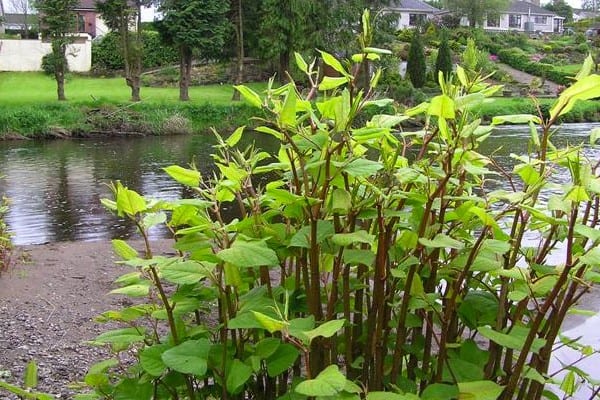Those who care about the nation’s native flora are often heard lamenting the presence of invasive species. Despite overtones of the blitz spirit, they are right to do so: not every invasive species comes from overseas, but they’re all adept at out-competing native species and reducing biodiversity. Gardening is about managing competition between communities of plants, so it’s especially ironic that many invasive species were first introduced and encouraged to spread by horticulturalists.
Tree of Heaven (Ailanthis altissima)
If you live in a town you’ll almost certainly have come across tree of heaven, since it’s planted so widely along Britain’s streets and in local parks. Originally from China, this deciduous species propagates from seed, which it broadcasts in great quantities from growing trees. Seeds are usually present in waste material resulting from tree removal, and tree of heaven also tends to produce large numbers of suckers.
Tree of heaven – often known as tree of hell in conservation circles – has a special trick up its sleeve to outcompete native species: it produces poisonous compounds that prevent the growth of other plants. The tree grows like a weed, but trying to inhibit its spread by severe pruning just seems to accelerate growth.
Rhododendron (specifically the hybrid Rhododendron x superponticum)
Volunteers in urban gardening schemes in the UK always spend a lot of their time “rhodo bashing,” The rhododendron is the legacy of the Victorian plant breeders who created this unusually vigorous hybrid and planted it almost everywhere. There’s no denying that the plant’s purple flowers are extremely pretty, but the downside is that its presence causes havoc in some of Britain’s most precarious ecosystems. On Lundy Island, rhododendron has even begun to threaten the existence of Lundy cabbage, a rare endemic species of brassica.
Controlling invasive rhododendron is almost as much of a headache as battling with tree of heaven. It involves cutting the plant at the base until a stump is exposed, then stripping away as much of the bark as possible to create a large surface area for the application of herbicide. Liquid weedkiller is then applied to the stump with a paintbrush. Over the next few days, pains must be taken to kill any suckers that sprout from the cut rhododendron.
Himalayan Balsam (Impatiens glandulifera)
Himalayan balsam is capable of growing up to 2.5m high in one growing season, making it the largest annual plant in Britain. It grows near water, and is often found by rivers and lakes, or in waterlogged meadows. This species spreads with alacrity, since it drops its seeds into moving water, but the mature plant is also capable of explosively broadcasting its seed as far as four metres away.
There are a couple of specific threats posed by Himalayan balsam; the first being that because its plentiful pollen is so attractive to insects, it may deprive other species of pollinators. The second threat is the negative effect the germinating seeds have on wetland ecosystems. Unlike the other species in this glossary, Himalayan balsam may be uprooted and carefully burnt to destroy the seeds.
Cotoneaster (Cotoneaster)
This popular shrub genus bears bright berries that are much loved by birds, the main reason for its wide distribution. Cotoneasters grow especially prolifically on limestone pavement, scree and cliffs, which is unfortunately also the preferred environment of many rare native and endemic plants. It is of course extremely difficult to remove them without also endangering the natives, and herbicide must be painstakingly applied to the cotoneaster stems on multiple occasions.
Britain’s native flora is worth protecting: there is so little of it and, because the last ice age was not so long ago, most of what is native to the UK is rapidly evolving. Horticulturalists were responsible for first introducing many of the plant species which are troublesome today, and gardeners have an important role to play in protecting biodiversity by controlling invasive plants. But the take-home message from this article is that they’re often incredibly difficult to get rid of, so in order to be effective it’s necessary to base all control attempts on solid research.
For more information about invasive plant species and how TP knotweed can help residents and commercial clients overcome them, get in touch today.
Call 0800 389 1911 or contact us online.




